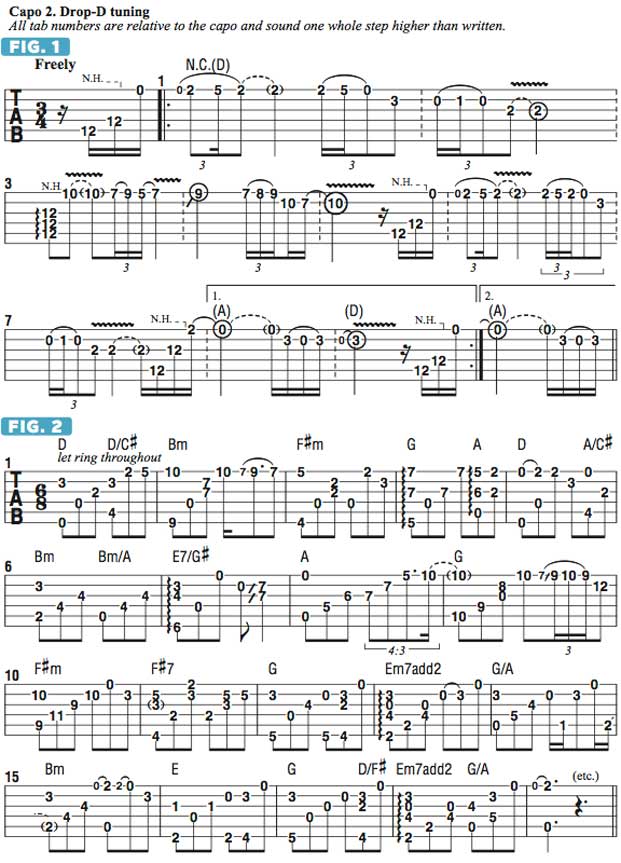How to Play My Rendition of Martin Taylor’s “One Day”

This month, I’d like to present my rendition of a beautiful song called “One Day,” which was written by my very dear friend Martin Taylor. (What a perfect name for an acoustic guitarist!)
This song means a great deal to me. Martin wrote it as a tribute to his late son, Stewart, who tragically passed away at too young an age.
We all miss Stewart very much. But when I play this song, I get to see his face in my mind, and I think of all of the things about him that I remember. Martin plays this song in a completely different way than my approach to the tune. I wanted to have a go at arranging it in my own style because I truly love the song, and it posed a wonderful challenge to find a means to express my own feelings with this great composition.
I play this song in drop-D tuning (low to high, D A D G B E) and with a capo at the second fret. As is always the case, I think of the guitar in a “transposing” way, meaning as if the capo were the nut.
FIGURE 1 represents the song’s intro, which is played freely, meaning there is no strict tempo. There is, however, an underlying feel of 3/4 meter, so the intro is presented in bars of 3/4 time. To me, it is most easily understood this way. This first section is constructed in a series of two-bar phrases, each of which is initiated with natural harmonics, played either as pickup notes before the downbeat or right on the beat.
Lightly lay your fret-hand ring finger on the strings directly above the 12th fret (12 frets above the capo, which would actually be at the 14th fret in this case) to produce natural harmonics when the strings are picked. These natural harmonics are allowed to ring out while I add melodic phrases on the top three strings, emphasizing the use of hammer-ons and pull-offs, with some subtle vibrato added.
FIGURE 2 represents the tune’s primary section, or verse, and at this point, I establish a steady 6/8 feel. The part is fingerpicked throughout; I use my thumb (with a thumb pick) and index and middle fingers to pluck the strings. On the downbeat of each bar (on “one”), the underlying chord is referenced by simultaneously picking a bass note along with a harmony note.
As you play and listen to the song, you’ll hear how the chord progression unfolds as a series of ringing arpeggios as I move from the low to the high strings, picking the individual notes of each chord after the initial pair of notes is sounded. In a few spots, such as in bars 4 and 7, I “rake” the strings, from low to high, by dragging my pick hand across them, sounding all the notes in quick succession to create a harp-like effect. This is my last GW column for the time being. I had a blast doing these lessons, and I hope you enjoyed them! Until next time, cheers!
Emmanuel Dexterity June 2016 FIGURE 1
Emmanuel Dexterity June 2016 FIGURE 2

Get The Pick Newsletter
All the latest guitar news, interviews, lessons, reviews, deals and more, direct to your inbox!
Tommy Emmanuel is an Australian guitarist, who's worked as a session player and won awards for his solo recordings. He is one of the finest acoustic players working today. In 2019, MusicRadar named him as one of the 10 best acoustic guitarists in the world.
“There are so many sounds to be discovered when you get away from using a pick”: Jared James Nichols shows you how to add “snap, crackle and pop” to your playing with banjo rolls and string snaps
Don't let chord inversions bamboozle you. It's simply the case of shuffling the notes around







![Joe Bonamassa [left] wears a deep blue suit and polka-dotted shirt and plays his green refin Strat; the late Irish blues legend Rory Gallagher [right] screams and inflicts some punishment on his heavily worn number one Stratocaster.](https://cdn.mos.cms.futurecdn.net/cw28h7UBcTVfTLs7p7eiLe.jpg)


